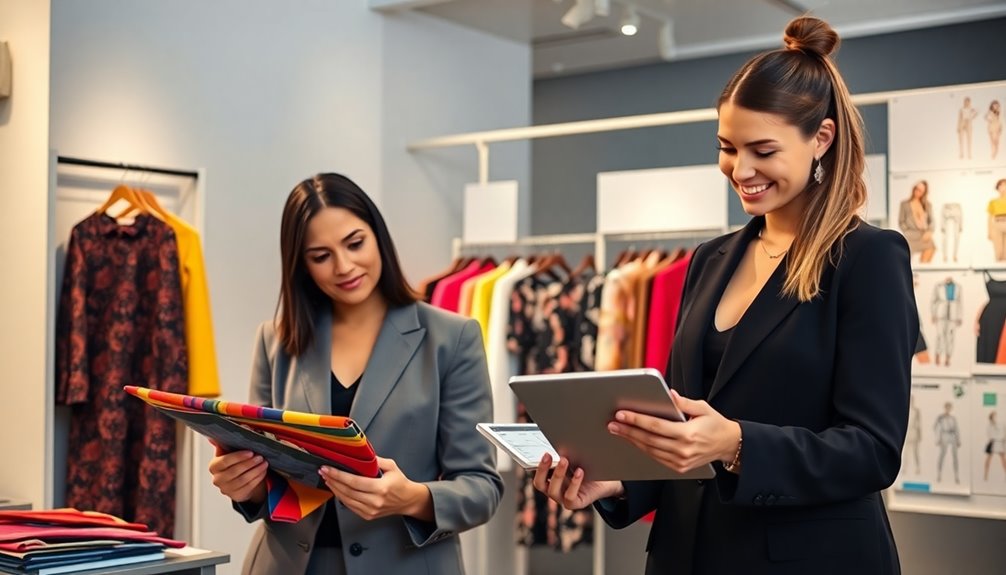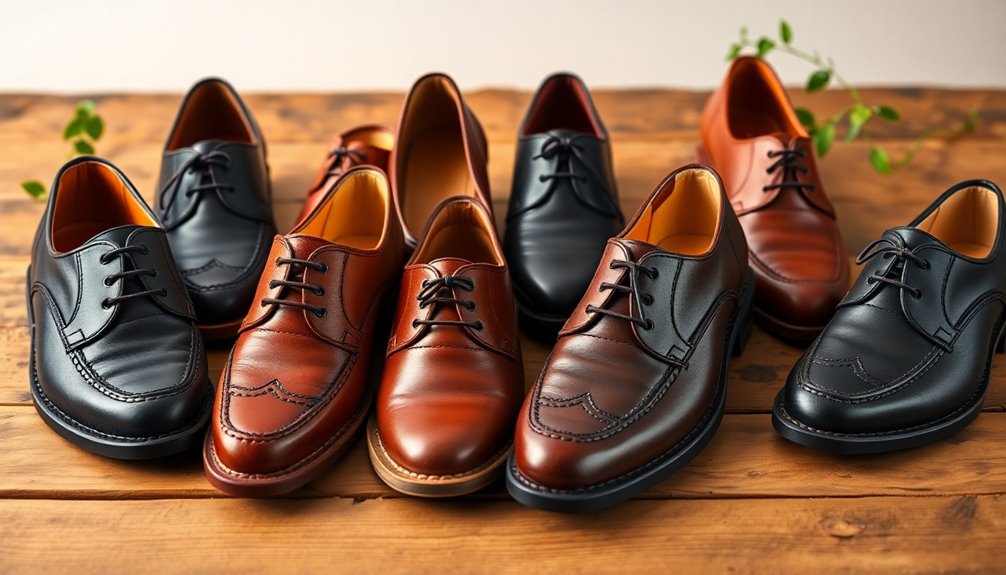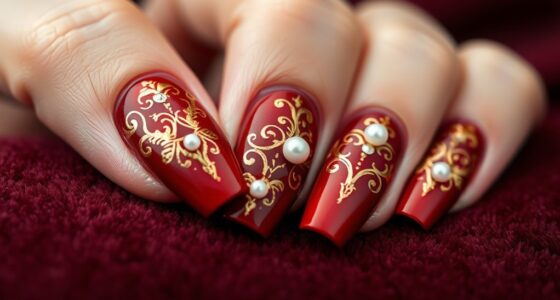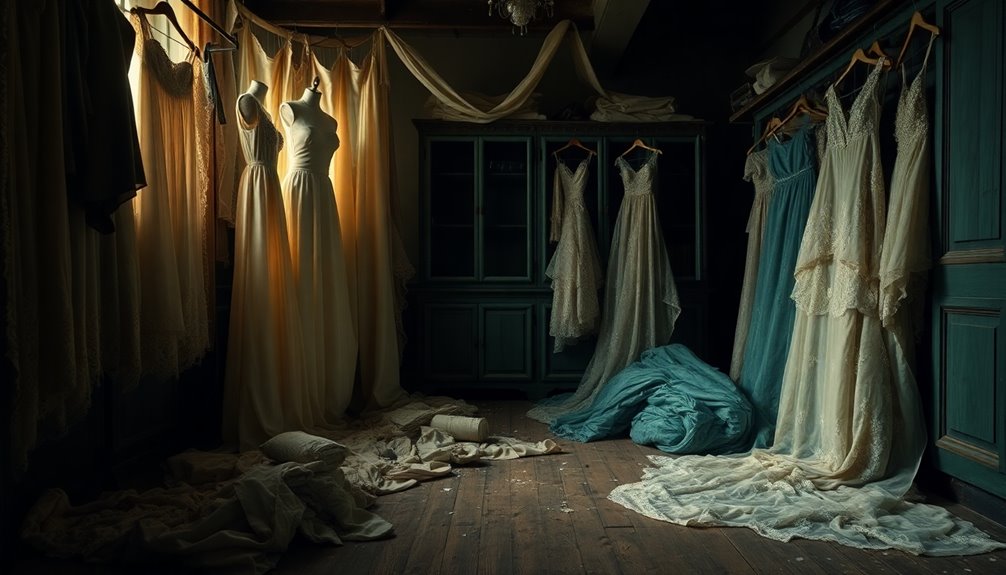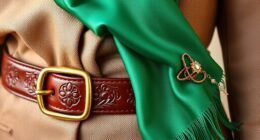Fashion buyers and merchandisers have unique roles in the retail sector. As a fashion buyer, you select products that match customer demand and negotiate prices with suppliers. You focus on curating collections and analyzing trends. On the other hand, merchandisers oversee the entire product flow, managing budgets and inventory. While buyers gather insights on consumer preferences, merchandisers collaborate on marketing strategies for launches. Both roles rely on data analytics, enhancing decision-making and trend forecasting. Understanding these differences can sharpen your career path, and if you stick around, you'll discover even more insights about these crucial fashion roles.
Key Takeaways
- Fashion Buyers focus on selecting products and negotiating prices, while Merchandisers oversee budgets and inventory management for retail collections.
- Buyers analyze market trends and customer demand, whereas Merchandisers ensure product alignment with financial objectives and sales strategies.
- Buyers attend trade shows to discover new trends, while Merchandisers collaborate with marketing for effective product launches.
- Both roles engage in inventory management, but Buyers curate collections while Merchandisers ensure compliance with assortment plans.
- Effective communication and collaboration between Buyers and Merchandisers are essential for maximizing sales potential and meeting market demands.
Roles and Responsibilities
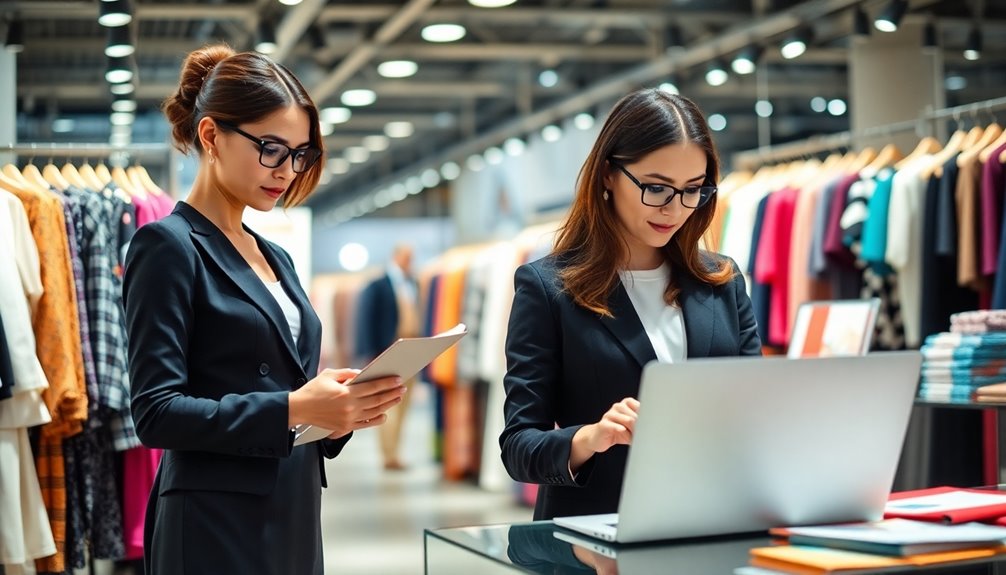
In the world of fashion, understanding the distinct roles and responsibilities of fashion buyers and merchandisers is essential for success.
As a fashion buyer, you focus on selecting products that align with customer demand and market trends. You negotiate prices with suppliers and manage logistics to guarantee timely delivery of goods. Additionally, you analyze buying patterns to forecast future trends and curate product ranges for specific retail outlets.
On the other hand, as a fashion merchandiser, you shape collections from concept to retail, overseeing product flow.
You collaborate with marketing and sales teams to launch products effectively, maintain communication across departments, and analyze product performance. Your role involves setting budgets and developing assortment plans to guide buyers while ensuring peak stock levels.
Key Differences Explained
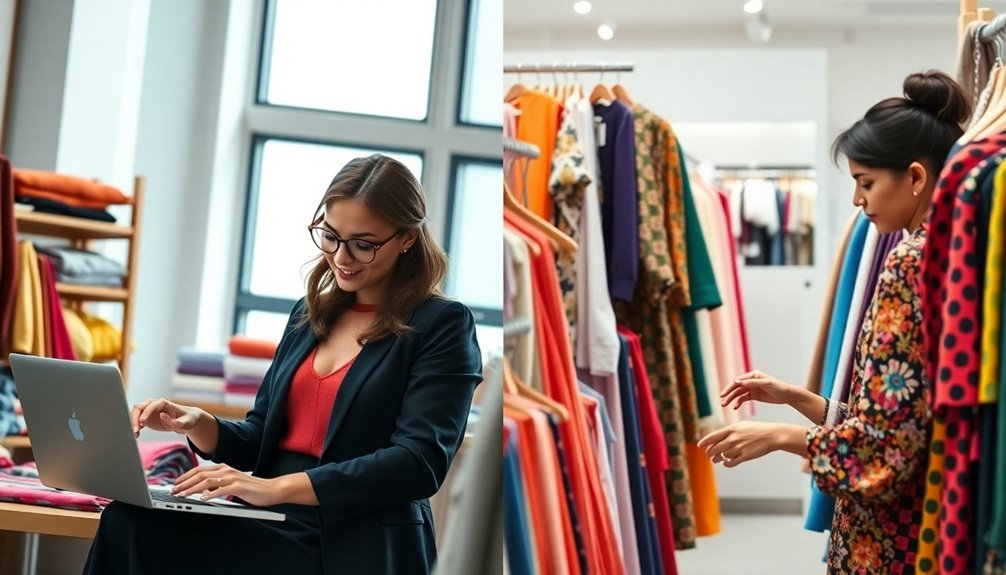
Understanding the differences between fashion buyers and merchandisers is key to grasping how both roles contribute to the industry. Buyers focus on selecting products and negotiating prices, guaranteeing they choose items that meet customer demand. They attend trade shows to stay updated on trends and manage logistics for timely delivery.
On the other hand, merchandisers oversee budgets and inventory, aligning stock levels with business goals. They collaborate with marketing and sales teams to guarantee successful product launches and analyze product performance for future planning.
While buyers curate collections, merchandisers ensure these selections fit within financial objectives, creating a balance that drives success in the fashion market. Understanding these distinctions clarifies how each role adds value to the fashion ecosystem.
Overlapping Duties
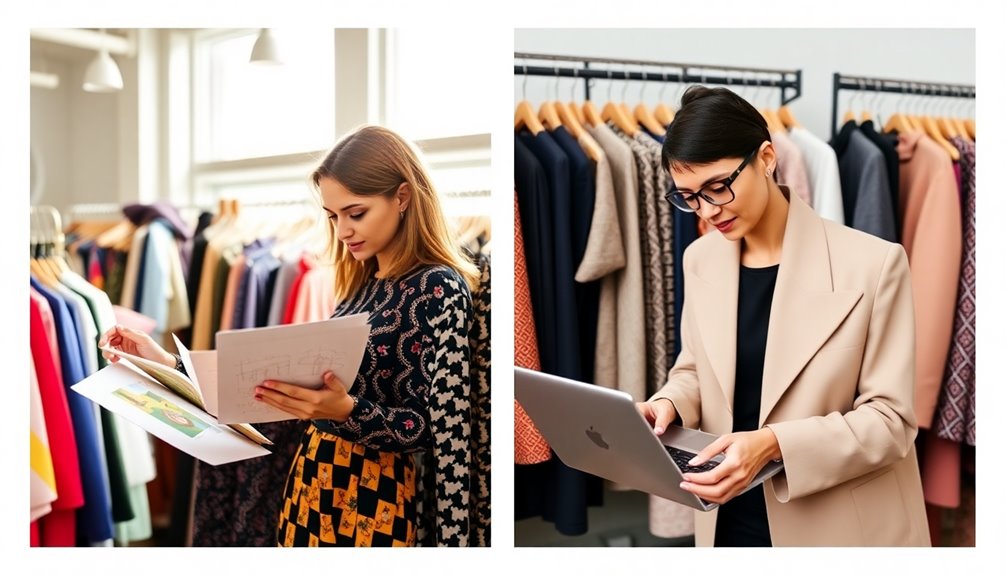
The collaboration between fashion buyers and merchandisers is vital in guaranteeing a successful product flow from selection to retail. Both roles share overlapping duties that enhance overall performance.
For instance, buyers must align their purchases with the budgets set by merchandisers, confirming financial feasibility. Similarly, merchandisers rely on buyers to select items that fit within their assortment plans, driving cohesive product offerings.
Additionally, both teams work together on inventory management, where accurate ordering guarantees ideal stock levels across various channels.
They also contribute to sales and marketing strategies, with buyers selecting products for promotions while merchandisers oversee the execution of these initiatives. This teamwork is essential for meeting market demands and maximizing sales potential.
Essential Skills Required

Collaboration between fashion buyers and merchandisers isn't just about shared duties; it also hinges on a distinct set of skills that each role brings to the table.
As a buyer, you need strong trend analysis and negotiation skills to secure the best deals while understanding consumer preferences. Your analytical abilities help you forecast trends and manage budgets effectively.
On the other hand, if you're a merchandiser, your focus shifts to creative problem-solving and deep knowledge of consumer behavior. You must interpret data and manage inventory to align with market demands.
Communication and collaboration are essential for both roles, ensuring that strategies and objectives remain cohesive throughout the buying and merchandising process for ideal business success.
The Role of Data Analytics
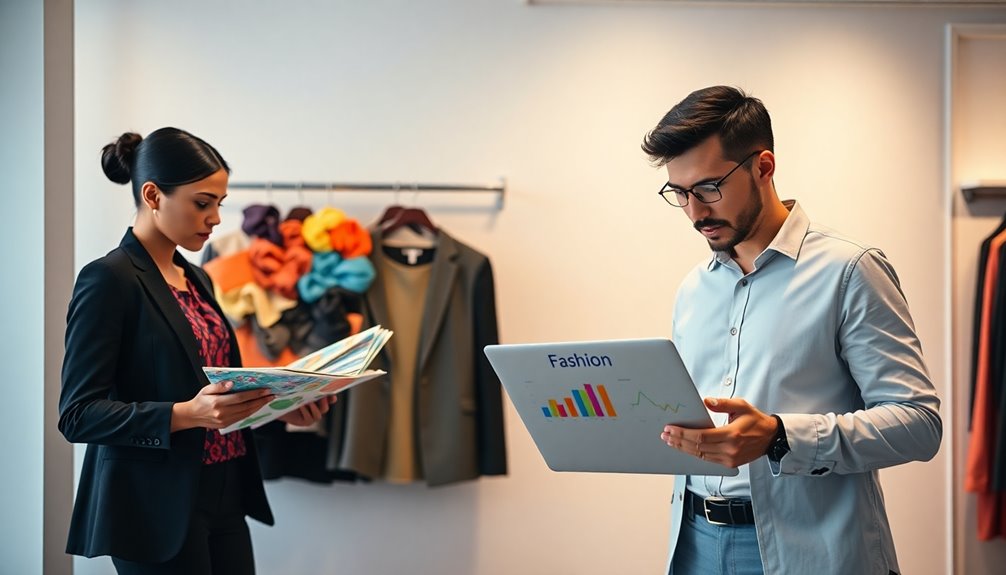
Harnessing data analytics is vital for fashion buyers and merchandisers to make informed decisions that drive sales and enhance inventory management.
You'll rely on data to analyze customer buying patterns, enabling you to forecast future trends effectively. By examining sales performance, you can identify bestsellers and make smart replenishment and markdown suggestions.
Data analytics also helps in optimizing inventory levels, ensuring you avoid overstocking while maintaining adequate stock to meet demand.
Furthermore, leveraging analytics gives you a competitive edge, allowing you to respond swiftly to market shifts and changing consumer preferences.
In this fast-paced industry, using data-driven insights isn't just beneficial; it's critical for sustained success and profitability.
Importance of Collaboration
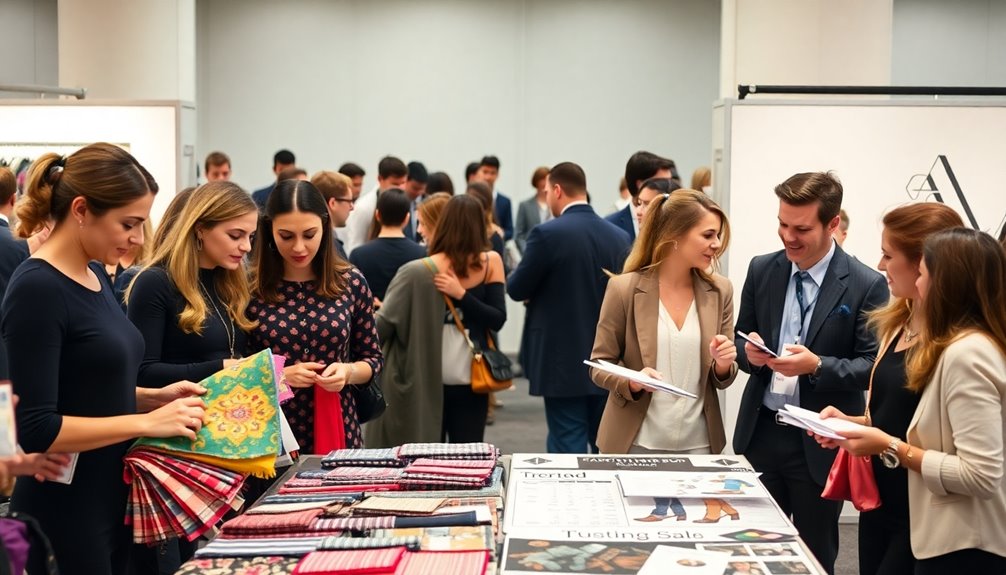
Effective teamwork between fashion buyers and merchandisers is essential for achieving business success. When you collaborate effectively, you enhance profitability and guarantee your brand stays competitive in a fast-paced market.
By aligning strategies, both roles can better anticipate consumer needs and preferences, leading to improved customer experiences.
- Joint efforts drive overall profitability through shared insights and strategies.
- Brand competitiveness is maintained as you adapt quickly to market trends.
- Continuous feedback fosters adaptability, allowing you to respond to changing demands seamlessly.
In today's dynamic fashion industry, collaboration isn't just beneficial—it's necessary.
Impact on Business Success
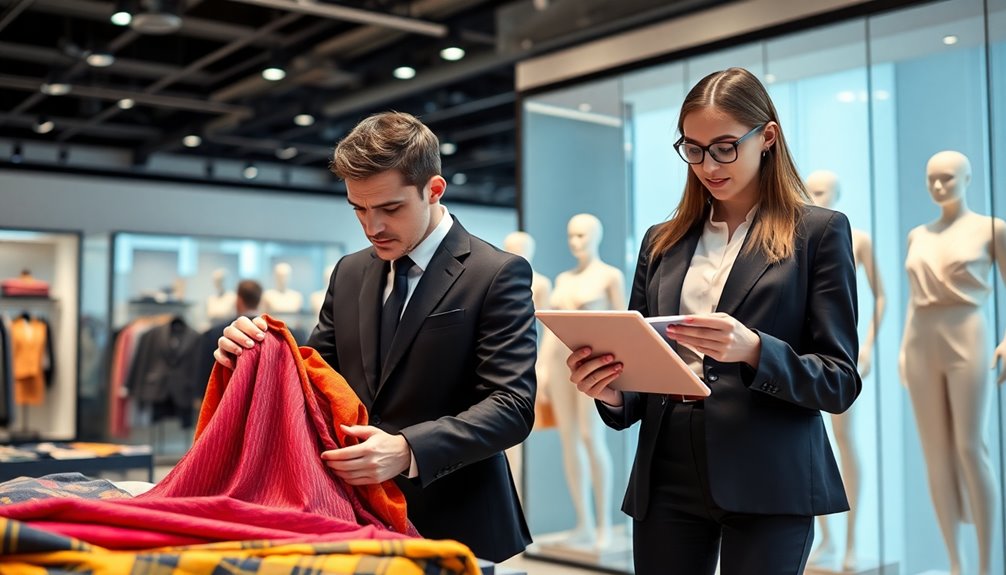
Maximizing the synergy between fashion buyers and merchandisers greatly impacts business success. When these two roles collaborate effectively, they create a seamless flow from product selection to sales.
Buyers focus on sourcing trendy items while merchandisers guarantee that these selections align with budgetary constraints and consumer demand. This partnership leads to smarter purchasing decisions, optimizing inventory levels, and minimizing overstock situations.
By analyzing sales data together, they can adjust strategies in real-time, enhancing profitability and brand competitiveness.
Ultimately, when buyers and merchandisers work in harmony, they not only cater to market trends but also elevate the customer experience, driving loyalty and repeat purchases, which are essential for sustained success.
Future Trends in Fashion
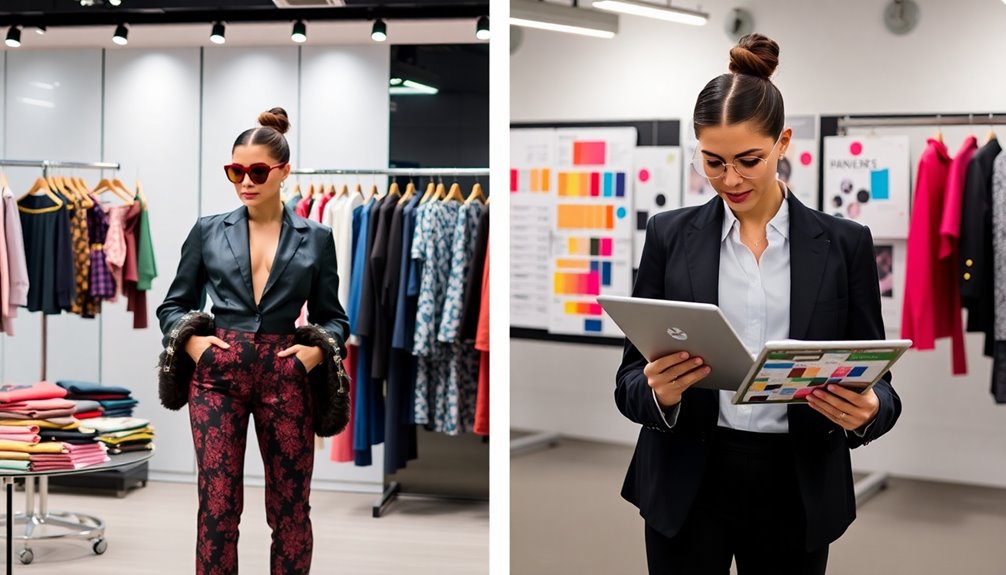
Anticipation is building in the fashion industry as emerging trends promise to reshape the landscape of retail and consumer engagement.
You'll see a rise in sustainable practices, as consumers increasingly demand eco-friendly options. Technology will also play a significant role, with AI and AR enhancing shopping experiences and personalizing recommendations.
- Increased emphasis on circular fashion, promoting resale and recycling.
- Integration of virtual and augmented reality for immersive shopping experiences.
- Growing importance of data analytics in predicting consumer preferences.
These trends not only reflect changing consumer values but also challenge you to adapt your strategies.
Frequently Asked Questions
What Educational Background Is Common for Fashion Buyers and Merchandisers?
Think of a fashion buyer or merchandiser as a skilled conductor of an orchestra, harmonizing various elements.
To excel in these roles, you often find a background in fashion merchandising, business, or marketing. Many have degrees in related fields, blending creativity with analytical skills.
Experience in retail also helps, as it sharpens your understanding of customer preferences and market dynamics.
Ultimately, a solid educational foundation sets you up for success in this vibrant industry.
How Do Fashion Buyers and Merchandisers Influence Sustainability in Fashion?
Fashion buyers and merchandisers play essential roles in promoting sustainability in fashion. You can see buyers selecting eco-friendly materials and brands that prioritize ethical practices, influencing what reaches consumers.
Merchandisers analyze sales data to identify sustainable products that resonate with customers, ensuring these items are well-stocked and promoted. By collaborating, they create strategies that highlight sustainable choices, encouraging consumers to make environmentally conscious decisions and driving the industry towards greener practices.
What Software Tools Do Buyers and Merchandisers Typically Use?
When you're diving into the world of fashion buying and merchandising, you'll find that both roles often rely on software tools like inventory management systems and data analytics platforms.
Tools such as ERP systems help you track stock levels and sales performance, while trend forecasting software keeps you updated on market shifts.
Additionally, project management tools enable collaboration with teams, ensuring smooth product launches and efficient communication throughout the process.
What Are the Career Advancement Opportunities in Buying and Merchandising?
In buying and merchandising, you'll find exciting career advancement opportunities.
You could progress from an entry-level position to roles like senior buyer or merchandising manager, where you'll lead teams and make strategic decisions.
Networking and gaining experience at trade shows can enhance your visibility.
Additionally, pursuing certifications or further education in fashion management can open doors to higher roles, like director of merchandising or product development, allowing you to shape brand strategies considerably.
How Do Cultural Trends Impact Buying and Merchandising Strategies?
Cultural trends greatly impact your buying and merchandising strategies. When you stay attuned to shifts in societal values, preferences, and lifestyles, you can select products that resonate with your target audience.
For instance, sustainability might drive you to source eco-friendly materials, while a resurgence of retro styles could influence your collections.
Conclusion
In the glamorous world of fashion, you'd think buyers and merchandisers are always at odds, battling over trends and inventory like rival fashion houses. Ironically, it's their collaboration that truly makes the magic happen. Without a buyer's keen eye for the next big thing and a merchandiser's knack for keeping stock flowing, the retail landscape would be a chaotic mess of unsold clothes and missed opportunities. So, next time you shop, remember: teamwork makes the dream work in fashion!
